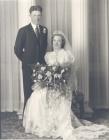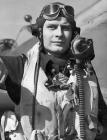2
Katherine (Flowers) Carr survived the torpedoing of the Athenia on Sept. 2, 1939. Originally from Leicester, England, she was returning to Canada after visiting her parents. The Okotoks Review reported in the July 19, 1940 issue: "Miss Flowers said she was in her cabin when the explosion took place and was dazed for over an hour from the shock. It was very difficult to find the stairway and they were continually falling over bodies. After they were in the life boats the Germans were still shelling the ship over their heads. She was picked up by the Norwegian freighter and taken to Galway, Ireland with many others. The people in Galway were very kind to them but they had to pass themselves off as Americans as the English are hated there. Flowers returned to England where she spent eight hours with her parents before sailing for Canada again. This time is was the Duchess of York. Two hours out from port a submarine was sighted, which they believed was sunk by the conveying warships. Miss Flowers had lost all she possessed. Her purse with $108 in it, her trunk, three suitcases and a hat box."4
Arnold RoselandFor over 50 years, the residents of St. Martin de Mailloc never knew the name of the courageous young pilot who was shot down over their French village during World War II.
The heroic pilot manoeuvred his plummeting aircraft into a nearby field in order to avoid crashing into a house full of people in the small village located in Normandy.
The mystery was finally solved in 1999 when the mayor of St. Martin de Mailloc, Pierre Behier tracked down the identification of the unknown pilot - it was Flt. Lieut. Arnold Roseland of Okotoks.
The only clues to his identity were his Canadian shoulder patch and a cigarette lighter which was inscribed 'Roseland.' The villagers buried the pilot in their cemetery under an anonymous marker.
6
Charles HalsteadStaff Sgt. Major Charles Halstead of the Canadian Armoured Corps, was awarded the Military Medal in March, 1944. His citation reads: "On Dec. 11, during the fighting beyond the San Leonardo bridgehead, it was necessary to send a squadron of tanks to protect the right flank of the attack. At the end of the day the squadron found itself in position where it could not be reached to supply vehicles with vitally necessary petrol, ammunition and rations. A mule train was organized to carry the needed supplies to the tanks in the dark. Staff Sergeant-Major Halstead went on ahead under direct enemy machine gun and sniper fire, arranged a rendezvous for the mule train with his squadron commander, later returning in daylight in direct view of the enemy after succeeding in placing the urgently needed supplies within reach of the tanks. The courage and initiative displayed by Staff Sergeant-Major Halstead during the time and his realization of the vital importance of the supplies resulted in not only allowing the squadron of tanks to hold their positions, but saved both tanks and information from being destroyed and the position from being overrun by the enemy.


